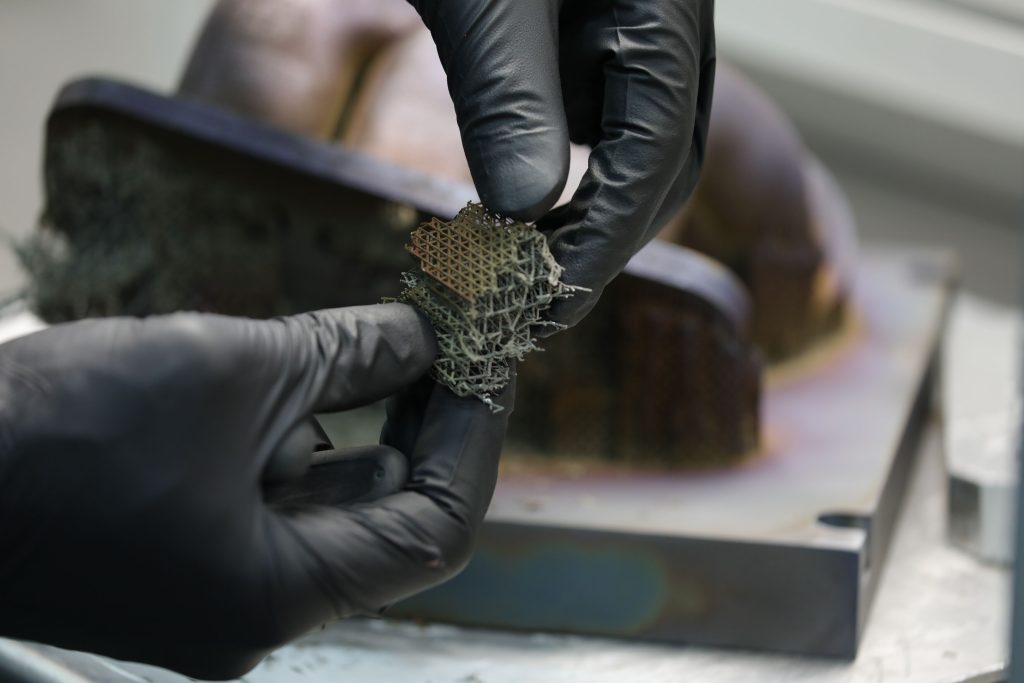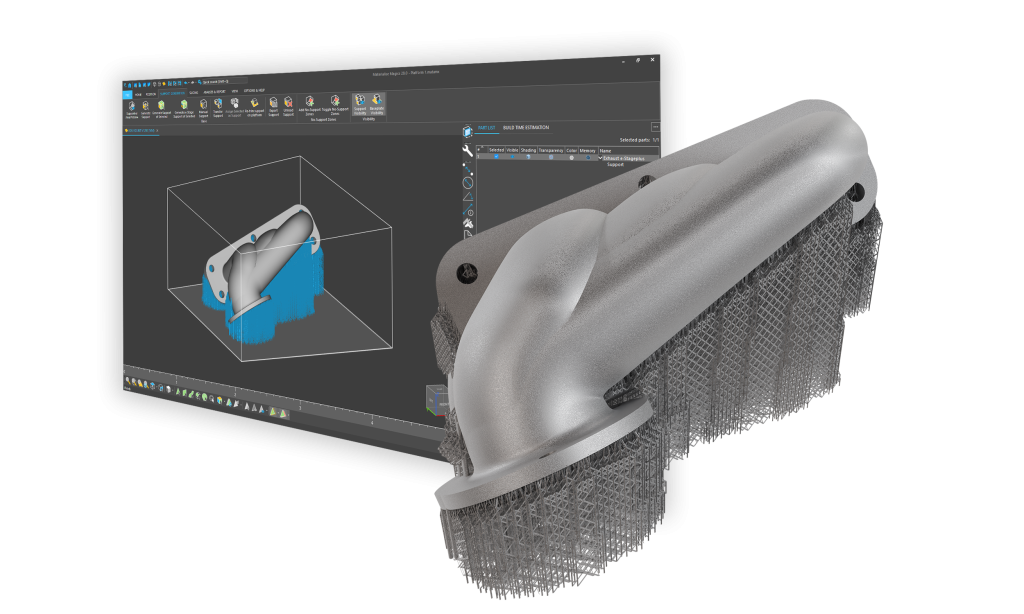Belgian 3D printing company Materialise is introducing its e-Stage for Metal+ software at the Additive Manufacturing Users Group (AMUG) 2024 conference in Chicago, taking place from March 10-14.
Utilizing physics-based modeling, the software streamlines data and build preparation for laser powder bed fusion (LPBF) systems, automating the generation of support structures. This solution aims to enhance the economic feasibility of metal additive manufacturing (AM). Although dominating the AM sector with a commanding 52% share of global revenue in 2022, LPBF also presents considerable challenges, rendering it one of the most complex technologies to navigate, says the company. As per a survey commissioned by Materialise, lack of expertise and the financial implications of production remain pivotal barriers hindering companies from embracing 3D printing. These challenges are particularly pronounced in the context of LPBF build preparation.
“By automating support structure generation with Materialise’s software, you can streamline your 3D printing process,” says Mirco Schöpf, Product Line Manager Software at EOS. “It simplifies support removal, reduces support volume up to 80%, eases powder extraction, and decreases build plate machining after an effortless part removal. We look forward to exploring e-Stage for Metal+ and discovering additional benefits.”
Visit booth 8 in salon D at AMUG, to know more about e-Stage for Metal+ and other software solutions by Materialise.

e-Stage for Metal+ software features
Materialise’s e-Stage for Metal+ predicts areas prone to deformation in the 3D printing process and generates needle-thin and cone supports accordingly. This dual-support approach enhances stability and optimizes heat distribution, mitigating part deformation and streamlining post-processing tasks.
Consequently, the software eliminates the trade-off between part quality and production expenses, presenting companies with a new perspective on their LPBF process, making it more economically viable and accessible. Automated solutions such as e-Stage for Metal+ reduce the learning curve, enabling users to seamlessly integrate the software with any machine and efficiently refine support generation, says the company.
“Metal AM users tend to overload parts with support structures during manual data preparation,” explains Ian O’Loughlin, Metal Practice Lead at Materialise. “They want to avoid defects and the costs associated with reprinting the parts. That’s why intelligent tools like e-Stage for Metal+ are crucial. Automating support structure generation at the sweet spot of printability and required supports saves time, material, and post-processing costs.”
Belonging to Materialise’s 3D Print Suite, e-Stage for Metal+ functions as a pivotal component within Magics, the company’s premier data and build preparation software. Magics stands out as a technology-agnostic platform, boasting compatibility with a wide array of import file formats and seamless integration with major 3D printing technologies. Through Magics, users gain access to sophisticated controls and automation features, empowering them to streamline and optimize their workflows with ease.
“We are continuously enhancing our software solutions to support AM users in their daily business,” says Lieve Boeykens, Solution Strategist at Materialise. “Automation can support AM users in bridging knowledge gaps to adopt the technology faster, accelerating return-on-investment, and helping them lower the overall production cost. Materialise’s e-Stage for Metal+ helps companies achieve economic viability.”

How metal AM software simplifies 3D printing
Several companies have recognized the potential of metal AM software in unlocking the full potential of metal additive manufacturing, enabling users to achieve high-quality, complex metal parts with efficiency and reliability. For instance, Dyndrite announced VIP Onboarding for its Dyndrite LPBF Pro software, tailored for Laser Powder Bed Fusion (LPBF) professionals, promising improved part printing, faster build rates, and cost savings.
As part of the EOS developer network, it targets the projected 23-30% annual growth in metal 3D printing, particularly in defense, aerospace, and automotive sectors. Dyndrite LPBF Pro offers unparalleled control, simplifying print prep and enabling experimentation for materials experts. Advanced geometry segmentation facilitates complex toolpath generation and systematic determination of optimal print parameters, promising enhanced performance and faster part production. This software integrates seamlessly with metal 3D printing systems, delivering versatility and efficiency.
Last year, Intech Additive Solutions collaborated with UIT-Dresden to enhance metal 3D printing using AMOptoMet Ultimate version 2.0 software, optimizing process parameters for metal LPBF systems. AMOptoMet software streamlines printing, ensuring top-quality surface finish and mechanical properties, shortening Design of Experiments (DOE). UIT-Dresden’s research validates its effectiveness across applications, aiming to refine material characterization and multiphysics simulations for further optimization.
Back in 2019, Renishaw and Identify3D demonstrated software designed to safeguard data in metal AM processes at RAPID + TCT. The Identify3D suite addressed security concerns by integrating intellectual property protection, manufacturing repeatability, and traceability into a comprehensive digital workflow, ensuring end-to-end protection.
What 3D printing trends do the industry leaders anticipate this year?
What does the Future of 3D printing hold for the next 10 years?
To stay up to date with the latest 3D printing news, don’t forget to subscribe to the 3D Printing Industry newsletter or follow us on Twitter, or like our page on Facebook.
While you’re here, why not subscribe to our Youtube channel? Featuring discussion, debriefs, video shorts, and webinar replays.
Are you looking for a job in the additive manufacturing industry? Visit 3D Printing Jobs for a selection of roles in the industry.
Featured image shows e-Stage for Metal+ software streamlines data preparation. Image via Materialise.


